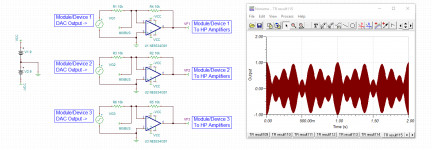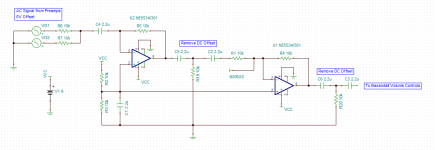Hey everyone, first time posting here. I'm currently working on a project wherein 7 users wearing headsets are able to talk amongst each other in a party-line manner. I've made and tested a custom circuit that supports this, but I'm having much trouble getting one of the required features of the circuit to work.
These singular boards must be able to be connected, or mixed, into other boards. In other words, I need the ability to expand my 7 channel party-line circuit to accommodate other exact boards. This will allow the entire system to have 7, 14, 21, etc. channels.
I thought I could adopt the same topology used to mix the output of the microphone preamps on each board, but it doesn't seem to be the case. The different modules, when connected, seem to fight each other. A lot of noise and clipping is present, and it is generally an unpleasant sound.
I've attached an image below to illustrate what I'm attempting to do. It's just a simple representation of what I'm currently doing. The only difference is that in my actual board, I'm using a single supply and the non-inverting input is connected to 1/2VCC. I also moved to using a ADC->DSP->DAC topology, which is shown in the images. Is virtual earth mixing the commonly accepted way of mixing/summing analog signals? Could there be an issue with multiple mix amps fighting each other? Potential grounding issues? I'm at a loss here and would appreciate any help I could get.
These singular boards must be able to be connected, or mixed, into other boards. In other words, I need the ability to expand my 7 channel party-line circuit to accommodate other exact boards. This will allow the entire system to have 7, 14, 21, etc. channels.
I thought I could adopt the same topology used to mix the output of the microphone preamps on each board, but it doesn't seem to be the case. The different modules, when connected, seem to fight each other. A lot of noise and clipping is present, and it is generally an unpleasant sound.
I've attached an image below to illustrate what I'm attempting to do. It's just a simple representation of what I'm currently doing. The only difference is that in my actual board, I'm using a single supply and the non-inverting input is connected to 1/2VCC. I also moved to using a ADC->DSP->DAC topology, which is shown in the images. Is virtual earth mixing the commonly accepted way of mixing/summing analog signals? Could there be an issue with multiple mix amps fighting each other? Potential grounding issues? I'm at a loss here and would appreciate any help I could get.
Attachments
Could you post the actual complete circuit that you are using? That's really necessary.
Do each of the op amps have an output coupling capacitor to block their output DC offsets?
Are there also input DC blocking capacitors?
Do each of the op amps have an output coupling capacitor to block their output DC offsets?
Are there also input DC blocking capacitors?
Last edited:
Sure! I've gone ahead and labeled as much as I can. For simplicity's sake, I truncated the image to only show my mixing stage. There are no input coupling capacitors, and the DC offset is only removed after the Baxandall volume control.
I've also attached an image where I added an output coupling capacitor to each op amp. Could this be a better solution to avoid issues when mixing separate modules together?
I'm a software guy by trade, and a fair bit of analog circuitry is new to me. Apologies if I gloss over simple details.
I've also attached an image where I added an output coupling capacitor to each op amp. Could this be a better solution to avoid issues when mixing separate modules together?
I'm a software guy by trade, and a fair bit of analog circuitry is new to me. Apologies if I gloss over simple details.
Attachments
Last edited:
You can't combine virtual ground mixing nodes like that, since the summing points will be at slightly different voltages due to spread in the offset voltages between opamps. This is one reason why they are fighting. In a mixing desk virtual-ground summing busses have a single output amplifier, you can't have independent amps on the same virtual ground bus. The other issue is that you have multiple feedback loops all trying to control the common bus, which is typically turns into an oscillator.
All inputs to the mixing point need to go through resistors (ie be voltage signals that are converted to currents by the resistor), as this allows the mixing node to find its natural voltage. To common the modules with virtual ground you'd need to cross connect as a full matrix of NxN resistors, which does not scale well (understatement).
So either you need a dedicated single summing amplifier which then broadcasts the result back to all the units on another bus, or an alternative strategy is to use voltage summing as that can be a bus between identical units:

Note that this isn't ideal as it relies on the common ground being noise-free which may be a problem. Using differential voltage summing is more likely to perform well. There's another issue which is that the gain is reduced every time another unit is commoned up due to the voltage divider effect.
Anyway your basic premise has a problem - party-line connections like this normally require noise-gating to be usable as background noises become dominant when many signals are combined.
When multiple people speak in a room they use directional hearing to distinguish who's speaking and "tune in" on the speaker. If you plonk a microphone in the centre of the room and listen via that its usually much lower quality signal then you might expect because the directional information is lost.
So I'd suggest adding a noise-gate for each input to try and knock-out the background sounds.
All inputs to the mixing point need to go through resistors (ie be voltage signals that are converted to currents by the resistor), as this allows the mixing node to find its natural voltage. To common the modules with virtual ground you'd need to cross connect as a full matrix of NxN resistors, which does not scale well (understatement).
So either you need a dedicated single summing amplifier which then broadcasts the result back to all the units on another bus, or an alternative strategy is to use voltage summing as that can be a bus between identical units:

Note that this isn't ideal as it relies on the common ground being noise-free which may be a problem. Using differential voltage summing is more likely to perform well. There's another issue which is that the gain is reduced every time another unit is commoned up due to the voltage divider effect.
Anyway your basic premise has a problem - party-line connections like this normally require noise-gating to be usable as background noises become dominant when many signals are combined.
When multiple people speak in a room they use directional hearing to distinguish who's speaking and "tune in" on the speaker. If you plonk a microphone in the centre of the room and listen via that its usually much lower quality signal then you might expect because the directional information is lost.
So I'd suggest adding a noise-gate for each input to try and knock-out the background sounds.
Last edited:


